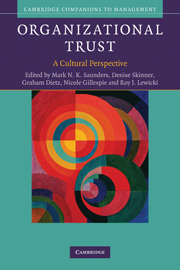Book contents
- Frontmatter
- Contents
- List of figures
- List of tables
- Note on editors
- Note on contributors
- Foreword
- Editors' acknowledgements
- Part I The conceptual challenge of researching trust across different ‘cultural spheres’
- Part II Trust across different ‘cultural spheres’: inter-organizational studies
- Part III Trust across different ‘cultural spheres’: intra-organizational studies
- 11 The role of trust in international cooperation in crisis areas: a comparison of German and US-American NGO partnership strategies
- 12 Antecedents of supervisor trust in collectivist cultures: evidence from Turkey and China
- 13 Trust in turbulent times: organizational change and the consequences for intra-organizational trust
- 14 The implications of language boundaries on the development of trust in international management teams
- 15 The dynamics of trust across cultures in family firms
- Part IV Conclusions and ways forward
- Index
- References
15 - The dynamics of trust across cultures in family firms
Published online by Cambridge University Press: 05 June 2012
- Frontmatter
- Contents
- List of figures
- List of tables
- Note on editors
- Note on contributors
- Foreword
- Editors' acknowledgements
- Part I The conceptual challenge of researching trust across different ‘cultural spheres’
- Part II Trust across different ‘cultural spheres’: inter-organizational studies
- Part III Trust across different ‘cultural spheres’: intra-organizational studies
- 11 The role of trust in international cooperation in crisis areas: a comparison of German and US-American NGO partnership strategies
- 12 Antecedents of supervisor trust in collectivist cultures: evidence from Turkey and China
- 13 Trust in turbulent times: organizational change and the consequences for intra-organizational trust
- 14 The implications of language boundaries on the development of trust in international management teams
- 15 The dynamics of trust across cultures in family firms
- Part IV Conclusions and ways forward
- Index
- References
Summary
Summary
The aim of this chapter is to provide new insight into how chief executive officers of family businesses (who are themselves family members) create trust with the firm's owners. I argue that, in the family firm, three interacting subcultures (family, business and ownership) influence chief executive officer (CEO) and owner behaviour in keeping with their governance roles. Because of distinct values and norms of behaviour, the interactions of these three subcultures are often a source of interpersonal conflict, and often undermine relationships of trust built up over generations. Through an exploratory case study and application of the Economies of Worth Model, this chapter examines and illustrates how CEOs of family firms enhance their legitimacy and thus build, maintain, and repair trust.
Introduction
Around the world, family firms dominate the economic landscape (Chrisman et al., 2005; Morck and Yeung, 2004). Family businesses are those where ownership and management are concentrated within a family unit, and where its members work to achieve or maintain intra-organizational family-based relatedness (Litz, 1995). Their corporate governance structure may be composed of the same people, or at least people from the same family (Gersick et al.. 1997; Wortman, 1994). This overlap of ownership and management influences the relationships between the CEO, the board of directors and the owners, as well as the strategy of the family firm (Melin, 2001; Nordqvist, 2005). Indeed, their relationships are founded on three interacting subcultures (family, business and ownership) that may conflict.
- Type
- Chapter
- Information
- Organizational TrustA Cultural Perspective, pp. 383 - 404Publisher: Cambridge University PressPrint publication year: 2010
References
- 2
- Cited by

